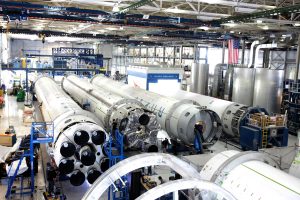 Künstliche Intelligenz (KI) bietet Unternehmen nicht nur wirtschaftliche Vorteile, sondern spielt auch eine zentrale Rolle bei der Förderung von Nachhaltigkeit. Die Integration von KI zur Steigerung der Unternehmensnachhaltigkeit stellt Unternehmen vor besondere Herausforderungen. Es gilt, das volle Potenzial von KI auszuschöpfen, um sowohl ökologische als auch ökonomische Ziele zu erreichen.
Künstliche Intelligenz (KI) bietet Unternehmen nicht nur wirtschaftliche Vorteile, sondern spielt auch eine zentrale Rolle bei der Förderung von Nachhaltigkeit. Die Integration von KI zur Steigerung der Unternehmensnachhaltigkeit stellt Unternehmen vor besondere Herausforderungen. Es gilt, das volle Potenzial von KI auszuschöpfen, um sowohl ökologische als auch ökonomische Ziele zu erreichen.
At the same time, we recognise that AI is currently being used primarily in manufacturing companies with an economic objective, in particular to optimise manufacturing processes. However, with rising energy costs and climate change, environmental sustainability is increasingly becoming a focus of business management. Used correctly, AI can deliver environmental value.
Sustainability
In today's business landscape, energy costs and climate change are critical factors that significantly influence business strategies. Companies face the challenge of balancing economic efficiency and environmental sustainability. In this context, Artificial Intelligence (AI) is taking on an increasingly important role.Energy costsCosts are rising inexorably and awareness of climate change is continuously growing. This is forcing companies to rethink their energy consumption and implement more sustainable practices. AI can provide critical environmental value in this regard. With the help of AI technologies, companies can optimise their manufacturing processes, reduce energy consumption and thus both cut costs and minimise their environmental impact. The focus is on a practical guide to help companies successfully implement and use AI to achieve both their economic and environmental goals. The combination of AI and sustainable practices promises not only environmental added value, but also long-term competitive advantages and a positive corporate image.
Energy costs
Costs are rising inexorably and awareness of climate change continues to grow. This is forcing companies to rethink their energy consumption and implement more sustainable practices. AI can provide critical environmental value in this regard. With the help of AI technologies, companies can optimise their manufacturing processes, reduce energy consumption and thus both cut costs and minimise their environmental impact.
Goals
The focus is on a practical guide to help companies successfully implement and use AI to achieve both their economic and environmental goals. The combination of AI and sustainable practices promises not only environmental added value, but also long-term competitive advantages and a positive corporate image.

Sustainability and the role of AI in corporate governance
Sustainability is playing an increasingly important role in corporate governance, especially in light of legal requirements to reduce greenhouse gas emissions. In Germany, for example, industrial companies must reduce their greenhouse gas emissions by 37 per cent from 2020 to 2030 in order to meet the targets of the Climate Protection Act (Federal Environment Agency 2022).
Customers and investors demand sustainability
Not only legislators, but also customers and investors are increasingly pushing for companies to take sustainability aspects and concrete sustainability goals into account. New technologies, especially artificial intelligence, are coming into focus as they offer promising opportunities to improve sustainability.
The role of AI in supporting sustainability goals
In this context, concrete questions arise: How can companies effectively use AI to achieve their sustainability goals? And how can they identify and exploit the potential of AI?
The importance of the right tools for sustainability
Choosing the right tools plays a crucial role in improving sustainability aspects. Here, the intelligent linking and evaluation of corporate data is of particular importance. This includes not only internal company data, but also sustainability data from the supply chain, energy supply and the life cycle of products through to recycling.
The support of AI in coping with complex data situations
The increasing amount and complexity of this data present companies with growing challenges. This is where AI can provide crucial support. Various AI technologies are available and are already being used in companies today. However, the focus is often on cost efficiency and increasing efficiency, while sustainability aspects are not yet sufficiently taken into account.
Potentials of AI for resource efficiency
Although AI technologies offer considerable potential, also in the area of resource efficiency, the motivation for their application in companies is often cost- and efficiency-driven. A survey conducted as part of the study "Potentials of Weak Artificial Intelligence for Operational Resource Efficiency" found that energy and material savings were rarely cited as the main motivation for using AI.

Intersection of sustainability and artificial intelligence
The focus so far in the application of artificial intelligence has been mainly in the business sector. Companies have focused on increasing efficiency, reducing costs and automating processes.
However, this development has also led to an increased demand for computing power, which in turn contributes to higher CO2 emissions. At the same time, the consideration of global environmental sustainability is becoming increasingly important for companies. Legal requirements such as the federal Climate Change Act, the European Green Deal and the Fuel Emissions Trading Act, as well as rising customer expectations, are forcing companies to rethink their environmental footprint and reduce CO2 emissions.
Although computationally intensive training phases are rare, companies should be aware that the deployment and training of AI may involve energy consumption and associated CO2 emissions. A careful balance therefore needs to be struck between the benefits of AI and its environmental impact.

Green AI for sustainable AI development
Green AI represents a promising alternative to integrate sustainability aspects into the development of AI processes and applications without neglecting economic interests. The term "Green AI" refers to AI research that aims to reduce environmental impact by using resources more efficiently (Schwartz et al. 2020).
Environmental sustainability as a principle
In contrast to conventional AI development, environmental sustainability should be considered as a fundamental principle for responsible AI development and application.
Challenges and research
The question of how to successfully implement Green AI is still in the early stages of research. A first step in this direction is for developers to be transparent about how resource-intensive their AI computations are. This includes the disclosure of training times, computing resources, model efficiency and similar factors. The goal is to make the ecological efficiency clear to the users and at the same time to offer a possibility of comparison with other AI models.

Production process optimisation for more efficiency
Production process optimisation aims to increase the output of products while reducing the need for input factors such as raw materials and supplies. Digitalisation enables the evaluation of extensive data to make processes more transparent and efficient, which increases productivity.
Energieintensive Produktionsprozesse und Umweltaspekte
Production processes are often energy-intensive and offer room for improvement in the areas of emissions and efficiency. The potential for reducing greenhouse gases is high, as production processes are often greenhouse gas intensive, especially if an emissions-intensive electricity mix is used. One possibility for process optimisation is, for example, the automated shutdown of machines during idle times.
Unterstützung bei der Konfiguration von Maschinenparametern
One application in production process optimisation is the support of machine operators in configuring machine parameters on individual or networked (packaging) machines. Due to material changes or variations in material properties, process adjustments and parameter changes are required. This can become a complex process that often requires experiential knowledge and can be challenging, especially for newcomers. Efficient parameterisation can improve production and save time.
Action guide for companies
The following is a proposed action guide and best practices for developing an AI application to enhance sustainability in the enterprise.

Developing and implementing a sustainability strategy
Developing and integrating a sustainability strategy into your business is critical. It is important to ensure that this strategy not only exists, but is also communicated internally and, where appropriate, externally to engage employees and relevant stakeholders. Continuously reviewing and adapting your sustainability strategy is also important.
Deriving sustainability goals
Man soll dafür sorgen, dass aus der Nachhaltigkeitsstrategie klare Nachhaltigkeitsziele für das Unternehmen abgeleitet werden. Die konkreten Zahlen müssen definiert werden und gegebenenfalls einen Nachhaltigkeitsstandard berücksichtigen. Diese Ziele sollten in regelmäßigen Zyklen überwacht werden.
Sustainability analysis and problem description
Identification of sustainability deficits and potentials, translation of challenges into concrete technical problems and formulation of clear technical optimisation tasks. Examine the suitability of AI use to investigate these tasks.
Appropriateness of the use of AI
The suitability of the use of AI for solving the set tasks is evaluated. A comparison is made between AI and conventional solution approaches in order to assess the expected sustainability potentials and benefits. The estimation of the financial expenditure as well as the conviction of the decision-makers in the company for the implementation are also part of the assessment.
Checking the prerequisites
Ensure the IT infrastructure, personnel, data and processes are in place to meet the prerequisites for using AI to increase sustainability. If necessary, this requires adjustments or training.
Project planning and technology selection
Consideration of whether the AI application should be developed internally or acquired externally is paramount. Planning the AI architecture, considering interfaces, data models and required software and AI components are essential steps. Likewise, ecological aspects related to emissions and energy consumption should be considered.
Project implementation with CRISP-DM
Ensuring a clear definition of the baseline situation and the availability of high-quality data. Identification of the optimal algorithms and models for the technical implementation of the problem. Verification of the performance of the AI application and its suitability for integration into productive use.

Integrating AI to improve sustainability requires a holistic approach. Companies should develop a clear sustainability strategy and derive targets that are regularly monitored and adjusted. Identifying sustainability gaps and opportunities is critical to formulating concrete technical problems that can be solved with AI applications. The use of AI should always be checked to ensure that it delivers the best results and that environmental aspects are taken into account. The conditions for the use of AI must be created, and project planning and technology selection should be carried out carefully. The CRISP-DM model provides a structured approach to successful project implementation.
Overall, it shows that AI can be a powerful tool for achieving corporate sustainability goals, provided a comprehensive and responsible strategy is implemented.
If you have any questions about the top retail trends, please do not hesitate to contact us. We can help you implement them or recommend a suitable partner.